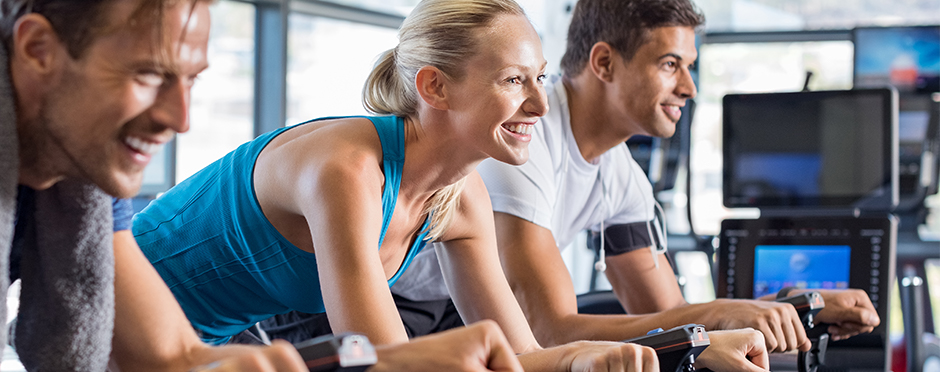
Common Workout Myths
Leave a CommentFitness and workout tips are everywhere: They can be found in magazines, TV shows, online articles, and even come within advice from friends. However, each tip seems to be different – sometimes even a contradiction of a different piece of health advice. To help you sort the fact from the fiction, read below to learn some common workout myths and truths that can help you have better, healthier and safer workouts.
1. Myth: Cardio Burns the Most Calories
Truth: If you want to burn more calories overall, and keep burning it after your workout is over, weight training needs to be incorporated into your routine. Weight training or strength training has been shown to keep you burning calories afterward due to post-exercise oxygen consumption (EPOC).2 Cardio exercise is needed to keep your heart healthy, but if calorie burn is your goal, don’t forget the resistance training.1,2
2. Myth: Stretching Is Best Before Working Out
Truth: Warming up with cardio before a workout is much more effective than stretching. It will get your blood flowing and warm up your muscles, which helps to prevent injury.3 A short burst of cardiovascular exercise such as riding a bike for five minutes or jogging in place is an easy way to start a work out. Dynamic stretching is good before a workout as well. Dynamic stretching is also known as “active stretching” where the muscle is being moved through its range and usually this is a range needed for the activity after the warm-up. Static stretching, which refers to when a stretch is held in place for a short amount of time, is better for improving flexibility and may be more beneficial after a workout.3
3. Myth: Weight Lifting Will Bulk You Up
Truth: Many people wrongly assume that lifting weights will make you bulk up, which they may not be interested in. Lifting either light weights or heavier weights can result in increased strength and muscle endurance.4 The idea of “bulking up,” such as bodybuilders do, is achieved usually through hours of lifting coupled with a diet designed to build muscle mass. The average person may see benefits of lifting like feeling stronger and looking more toned.
4. Myth: It’s Too Late/I’m Too Old To Get In Shape
Truth: It’s never too late to begin a healthier routine. There is no age limit on the body’s ability to gain strength. If you don’t exercise at all, start by walking 5 to 10 minutes a day, gradually increasing the time and adding in strength training as your tolerance increases.
5. Myth: You Need A Gym Membership To Get Results
Truth: You don’t need a gym membership or major equipment to work out. A yoga mat, a couple lightweight dumbbells, resistance band, or even a chair, is all that is needed to get a full-body workout at home. There are even many exercises that require no equipment at all, like squats and planks.
6. Myth: “No Pain, No Gain”
Truth: Some muscle soreness is to be expected during a workout, especially if you’re trying a new exercise or lifting a heavier weight. However if you’re in serious pain, stop what you’re doing. It doesn’t mean you’re working harder or getting stronger, it usually indicates injury may be occurring. Generally, workouts should be relatively pain free, but you may feel fatigue during a workout or muscle soreness after a workout.
If you do experience lingering pain after a workout, make sure to request a free assessment at your nearest Athletico location. Free assessments are available in-clinic or virtually through our Telehealth service.
The Athletico blog is an educational resource written by Athletico employees. Athletico bloggers are licensed professionals who abide by the code of ethics outlined by their respective professional associations. The content published in blog posts represents the opinion of the individual author based on their expertise and experience. The content provided in this blog is for informational purposes only, does not constitute medical advice and should not be relied on for making personal health decisions.
References:
1. Fletcher, G. F., Blair, S. N., Blumenthal, J., Caspersen, C., Chaitman, B., Epstein, S., … & Piña, I. L. (1992). Statement on exercise: benefits and recommendations for physical activity programs for all Americans-a statement for health professionals by the Committee on Exercise and Cardiac Rehabilitation of the Council on Clinical Cardiology, American Heart Association. Circulation, 86(1), 340.
2. Schuenke, M. D., Mikat, R. P., & McBride, J. M. (2002). Effect of an acute period of resistance exercise on excess post-exercise oxygen consumption: implications for body mass management. European Journal of Applied Physiology, 86(5), 411-417.
3. Page P. CURRENT CONCEPTS IN MUSCLE STRETCHING FOR EXERCISE AND REHABILITATION. International Journal of Sports Physical Therapy. 2012;7(1):109-119.
4. Mekary RA, Grøntved A, Despres J-P, et al. Weight training, aerobic physical activities, and long-term waist circumference change in men. Obesity (Silver Spring, Md). 2015;23(2):461-467. doi:10.1002/oby.20949.
